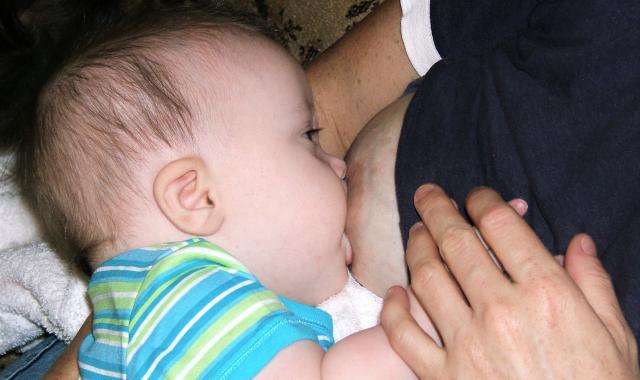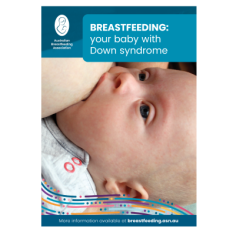Breastfeeding is an important step in the early months of your baby's life.

Congratulations on the birth of your baby! Although everything may not be as you expected, or wished for, you are not alone and will find lots of support as you and your family care for your little one and help them grow and learn.
If you have just discovered that your baby has Down syndrome, or even if you have known for some time and are now thinking about breastfeeding, you may be experiencing mixed emotions. This is very natural as you wonder what lies ahead for you and your baby.
The extent to which children are affected by Down syndrome varies widely. These children achieve the milestones of child development, but generally a little more slowly. Breastfeeding can be an important step in the early months and years of your baby's life.
One of the most important things you can do initially is to seek help, get information and reach out to others who have experienced bringing up a baby with Down syndrome.
Each Australian state and territory has a branch of the Down Syndrome Association (see below for details). They may be able to supply you with details of local support groups for parents. Many people find this contact very helpful. Your medical adviser will also be able to provide you with information about access to early intervention programs in your area.
A good knowledge of how breastfeeding works will help you establish breastfeeding more easily. Our booklet, Breastfeeding: your baby with Down syndrome, contains detailed and up-to-date information, plus mothers' comments and stories, photos and suggestions.
You may find that it is very helpful to contact an ABA counsellor, a lactation consultant or your child health nurse. Maternity units in many large hospitals employ lactation consultants, while others work in private practice. As well as supporting you as you and your baby learn to breastfeed, they may be able to put you in contact with another mother who has breastfed a baby like yours.
Gain support from your health care team. Download the Fact sheet for health professionals “Breastfeeding an infant with Down syndrome” to give to your midwife and other health practitioners.
The best solution is to talk to other mums with lived experience.
Breastmilk is nature's food for all babies. Breastfeeding your baby is much more than nutrition. It provides food, comfort and stimulation of all of baby's senses.
Babies with Down syndrome have an increased risk of infection, particularly respiratory infections. Your breastmilk contains anti-infective factors including antibodies against germs that you and your baby are exposed to.
Babies with Down syndrome often have low muscle tone. The muscles of your baby's lips, tongue and face are all toned and strengthened by breastfeeding. It helps prepare your baby for eating other foods and for speech development.
Babies with Down syndrome are more likely to be born prematurely. Premature babies rely on the protective factors in colostrum and breastmilk to thrive. Our booklet Breastfeeding: your premature baby contains detailed and up-to-date information, plus mothers' comments and stories, photos and suggestions.
Breastfeeding your baby
Having low muscle tone means your baby may have trouble getting their mouth around your nipple and attaching correctly to your breast. Your baby may also have trouble coordinating their sucking, swallowing and breathing and may gulp as they feed. They may get less milk for their effort, and they often get tired quickly. This can and will improve with time and patience.
Breastfeeding itself will improve your baby's muscle strength, which will help compensate for the low tone. As baby gets stronger and learns to breastfeed more effectively, they will be able to drink more milk.

Positioning your baby to breastfeed
It is important that your baby is well positioned at your breast. Their body needs to be well supported so they use as little energy as possible holding their head and neck up.
You can hold your baby lying on their side across your lap, chest facing yours, their lower arm around your waist. This enables baby to feed without having to turn their head to take the nipple. Some mothers use a sling to hold their baby's body in a C-shape keeping their head and bottom tucked in.
You can use pillows to hold baby up high enough so that their mouth is level with your nipple. Use an extra pillow to raise their bottom to near the level of their head. This may help if low muscle tone is causing sucking problems.
Alternatively, you may like to use the 'underarm hold'. Put a pillow at your side and another pillow across it and your lap. Rest your baby's bottom on the first pillow and support their back on your forearm while you cradle their head in your hand. You can try different feeding positions, until you find one that suits your baby.
Helping your baby to attach
Many babies need help to attach well to the breast. Your baby may also be helped if you support your breast and their chin while they feed. Cup your hand under your breast, then slide it forward so that three fingers support your breast. Make a U-shape with your thumb and first finger and support your baby's jaw in that U. This is called the Dancer Hand position.
It will help if you start your milk flowing before you put your baby to the breast. They won’t have to spend energy sucking without getting anything. Gentle hand expressing, rolling your nipple between your thumb and forefinger, gentle massage and perhaps a warm face washer on the breast will encourage your milk to let down.
Soften your areola if you need to make it easier for your baby to attach.
Try baby-led attachment
All babies are born with the instinctive knowledge and ability to get themselves to their mother's breast and to attach themselves correctly, with their mother's support. Spending one-on-one, skin-to-skin time with your baby when you are learning to breastfeed will help to allow these 'baby-led attachment' instincts to work.
If your baby is having trouble sucking correctly, contact a lactation consultant, child health nurse, ABA breastfeeding counsellor or your medical adviser. There are techniques such as cup-feeding and aids such as nipple shields, which may be helpful.
Hear from other mums
Breastfeeding helped with my bonding to James initially when my world was turned upside down by his arrival.
I was encouraged by the Early Intervention Centre to breastfeed because it helps with lip closure and can discourage tongue thrusting as the child gets older.
In the early weeks Tamsyn would make gasping, choky noises during feeds. After some trial and error, a more upright feeding position seemed to minimise this.
The best solution is to talk to other mums with lived experience.
Although everything may not be as you expected, or wished for, you are not alone and will find lots of support as you and your family care for your little one and help them grow and learn.
Breastfeeding your baby may have some challenges, but as baby grows, they will become stronger and more able to feed effectively. Make use of all the support services available including speaking with an ABA counsellor.
Down Syndrome Federation
The Down Syndrome Federation provides a range of supports and services for new parents and families. The national webpage links to all state pages.
Growth charts
Growth Charts for Children with Down syndrome
© Australian Breastfeeding Association April 2022
Find out more about breastfeeding your baby
Evidence-led info and practical tips from our Special Situation Information Series
Breastfeeding: your baby with Down syndrome



